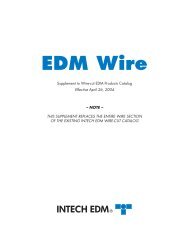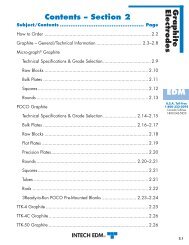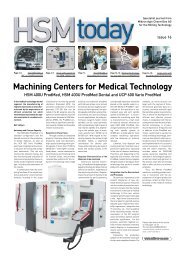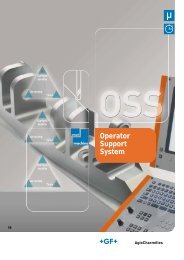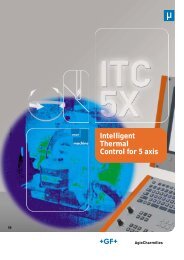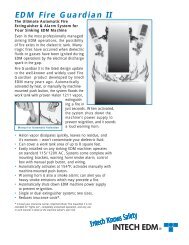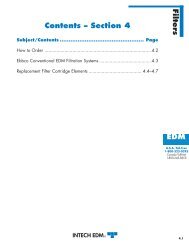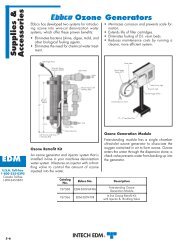E EXPERIENCE 28 - GF AgieCharmilles US
E EXPERIENCE 28 - GF AgieCharmilles US
E EXPERIENCE 28 - GF AgieCharmilles US
You also want an ePaper? Increase the reach of your titles
YUMPU automatically turns print PDFs into web optimized ePapers that Google loves.
37<br />
AGIE experience<br />
No <strong>28</strong> January 2007<br />
4. An optimum cutting technology<br />
is selected from «Teccut»<br />
or the technology is retrieved<br />
from «Workmodel»,<br />
a module for repeatedly recurring<br />
jobs.<br />
5. The PCD disk is clamped on<br />
the Agiecut Progress 2.<br />
6. Agiesetup 3D carries out<br />
measurement cycles automatically<br />
with the EDM wire<br />
and the probe. In this way,<br />
the 0-point is determined<br />
exactly as the reference and<br />
the location of the PCD disk<br />
in the ED wire-cutting machine<br />
is fixed<br />
7. The contours are cut with a<br />
full cut using a Berocut<br />
0.25 mm wire.<br />
8. The PCD cutting tips are taken<br />
out as drop-out parts<br />
and the PCD disk is unclamped.<br />
9. The milling cutter shank<br />
made of tungsten is then<br />
clamped horizontally. «Agiesetup<br />
3D» then determines<br />
any possible twisting of C-<br />
axis so that the cutting of<br />
the shank to length will take<br />
place 100 percent in right<br />
angle.<br />
10. The milling cutter shaft is<br />
cut to exactly the required<br />
length with one main cut.<br />
11. In the meantime, the cutting<br />
contour for the tip seats on<br />
the shank is prepared with<br />
Peps.<br />
12. «Scriptfile» makes a direct<br />
transfer of the geometries,<br />
complete with the cutting<br />
technologies, to Agiecut<br />
Progress 2 possible.<br />
13. The shank is clamped vertically<br />
and also plotted with<br />
«Agiesetup 3D», with the<br />
probe in A, B and Z-axis direction<br />
and with the wire in<br />
X and Y-axis direction. In accordance<br />
with the measurement<br />
data determined, the<br />
control system then organises<br />
the machining program<br />
around these values.<br />
14. The symmetrical, tapering<br />
tip seats of the shank are<br />
ED wire cut.<br />
15. The shank is unclamped and<br />
the PCD cutting tips are<br />
applied to the tip seats by<br />
means of induction welding.<br />
16. The now complete milling<br />
cutter is clamped horizontally<br />
on to the Agiecut Progress<br />
2 once again in such a<br />
way that the 2 PCD cutting<br />
tips are aligned horizontally.<br />
The measurement data on<br />
the milling cutter head are<br />
recorded with «Agiesetup<br />
3D» so that the machining<br />
program can align again.<br />
17. The PCD cutting tips receive<br />
their final cutting contour by<br />
means of a taper cut by<br />
Agiecut Progress 2, with<br />
exactly the required angle.<br />
In this connection, 0.05 mm<br />
are left in place for the polishing.<br />
18. As a final step, the PCD cutting<br />
tips are polished with a<br />
diamond lapping machine.<br />
The machining steps can, it is<br />
true, vary somewhat according to<br />
the order, however, they do show<br />
how rationally ED wire cutting<br />
can be employed for the production<br />
of PCD tipped milling cutters.<br />
The absolute highlight in<br />
this connection for Hamilton<br />
Lichfield Ltd. is the «Setup 3D»<br />
function which is employed for<br />
each set-up procedure. Multiplied<br />
over a year, a saving in time<br />
amounting to days results.<br />
The slot milling cutter is checked<br />
once again for contour accuracy, symmetry<br />
and precision on an optical measuring<br />
system.<br />
PCD inserts are inductionwelded into<br />
the tip seats of the shaft.






